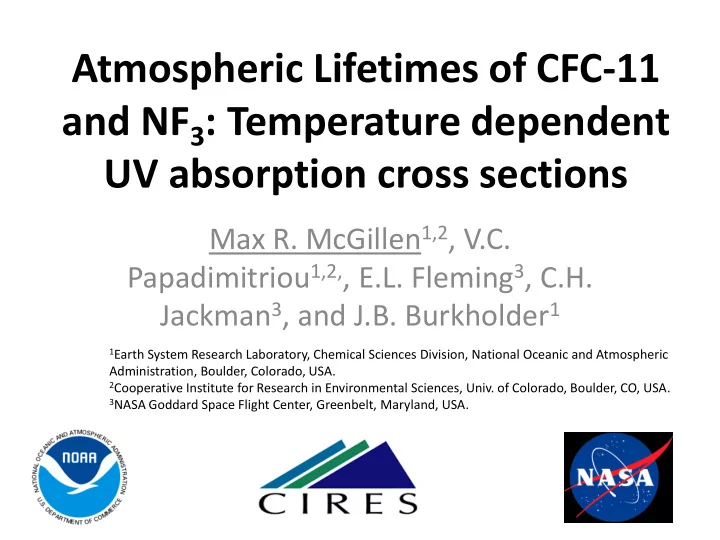

Atmospheric Lifetimes of CFC-11 and NF 3 : Temperature dependent UV absorption cross sections Max R. McGillen 1,2 , V.C. Papadimitriou 1,2, , E.L. Fleming 3 , C.H. Jackman 3 , and J.B. Burkholder 1 1 Earth System Research Laboratory, Chemical Sciences Division, National Oceanic and Atmospheric Administration, Boulder, Colorado, USA. 2 Cooperative Institute for Research in Environmental Sciences, Univ. of Colorado, Boulder, CO, USA. 3 NASA Goddard Space Flight Center, Greenbelt, Maryland, USA.
Motivation for accurate laboratory measurements • Experimental measurements of σ ( λ , T) represent a constraint on: – Atmospheric lifetimes – Global-warming potentials – Ozone-depletion potentials • Interpretation of field data • Increased accuracy/ reduces uncertainty in model calculated lifetimes
Outline • Temperature dependent absorption cross section measurements presented for CFC-11 and NF 3 • Measurements are compared with current recommendations for modeling • The impact of including these new data on 2-D modeled atmospheric lifetimes are discussed
Why measure CFC-11 σ ( λ , T)? • UV photolysis is the major loss process in the atmosphere • Many room temperature measurements, but relatively few studies at stratospheric temperatures • Model recommendations primarily based on two studies, but there is some discrepancy (as much as 25%) • This level of uncertainty has an impact on calculated atmospheric lifetimes
Absorption cross section measurements Monochromator PMT DAQ D 2 Raw data lamp Exhaust N 2 N 2 Inlet P Coolant Coolant T range: 216–296 K, λ range: 190–230 nm Typical precision: ± 0.5%, accuracy: ± 4% (2 σ )
Absorption cross section measurements Monochromator PMT DAQ D 2 lamp Exhaust Beer-Lambert Law A ( λ ) = σ ( λ , T) × L × [CFC-11] N 2 N 2 Inlet P Coolant Coolant T range: 216–296 K, λ range: 190–230 nm Typical precision: ± 0.5%, accuracy: ± 4% (2 σ )
Cross section results • Systematic decrease in σ with T • Monotonic decrease in σ with λ • Manuscript in prep.
Cross section results • Optimized fit with a 5 th -order polynomial • T-dependence is observed in the critical wavelength region
Comparison with parameterization • Data is fitted well with the parameterization • High-precision exp. data • Appropriate fitting routine for model calcs.
Comparison with JPL recommendation • Simon et al . is the current JPL recommendation • Simon et al . data shows devation in T-dep, >20%
Comparison with literature • Both Mérienne and Chou studies are found to be in good agreement • Some systematic differences at shorter wavelengths
2-D modeling results Loss processes Molecular loss rates Critical λ range for atmospheric loss: • 190–230 nm Most CFC-11 destruction between • 15–30 km Local lifetime in the stratosphere ~1 • year Calculated global lifetime: 58.1 years •
2-D modeling results SPARC lifetime report This work ± 25% → 54.3 – 66.3 year lifetime ± 4% → 57.4 – 58.8 year lifetime Global average lifetime: 60.2 years Global average lifetime: 58.1 years
CFC-11 summary • Data impacts calc. lifetimes from current JPL • Modeled lifetime decreased from 60.2 (SPARC) to 58.1 years (this work) • Uncertainty in stratospheric photolysis rate decreased from ~25% to 4% • Leading to a range in atmospheric lifetimes ± 0.7 years (57.4 – 58.8 years)
NF 3 • Persistent greenhouse gas with a high GWP (~500 year lifetime) • Mixing ratios are increasing in the atmosphere • Previous studies focused on the room temperature σ (biased model calculated lifetimes) • NF 3 σ ( λ , T) measured using the same approach as was used for CFC-11
2-D modeling results • Inclusion of temperature dependence in σ is important • Maximum atmospheric loss is between 25–50 km • Papadimitriou et al . 2013 (GRL)
2-D modeling results • Inclusion of temperature dependence in σ is important • Maximum atmospheric loss is between 25–50 km • Papadimitriou et al . 2013 (GRL)
NF 3 summary • Inclusion of temperature dependence of the NF 3 UV absorption spectrum, the calculated global lifetime is increased from 484 (without) to 585 (with) years (includes O( 1 D) losses 29%) • NF 3 exhibits a strong temperature dependence to σ ( λ , T), ~45% decrease at 210 nm 100 yr time horizon = +1.1% (19,700) • GWP 500 yr time horizon = +6.5% (17,700)
Any questions?
Recommend
More recommend